DISCLOSURE: This post may contain affiliate links, meaning I get a commission if you decide to make a purchase through my links, at no cost to you. Please read my disclosure for more info.
I’ve had a lot of people asking for my Fermented Jalapeno Hot Sauce Recipe and also just asking in general “How do you make homemade hot sauce?” so I figured I’d let you in on my secret.
To go along with this recipe, I also cover this in Episode 12 – How to Make Homemade Fermented Hot Sauce.
We also have an episode on our YouTube Channel! Make sure to subscribe so you don’t miss a thing.
Got Flavor in Your Hot Sauce?
If you want a hot sauce that has an amazing flavor with strong notes of garlic and onion but also has that great tangy vinegar flavor that you’d expect of a homemade hot sauce that you also wouldn’t be able to buy in the store, then you should love this recipe. It’s not the hottest hot sauce in the world unless you modify it and put habaneros or if you dare ghost peppers or scorpion peppers, but for myself, I really love sticking to the great flavor of Jalapenos.
I buy Jalapenos several quarts at a time from the farmer’s market at a discount and most of the time make very large batches of this that I can split up into two categories after they’re done fermenting. The two ways I like to use this recipe is for:
- Fermented peppers that will be used on sandwiches and also rice & bean dishes like Indian
- Fermented peppers that are destined to be blended up and then funneled into jars or bottles for amazingly flavorful hot sauce
First I’ll go over the process of how to make homemade hot sauce followed by my favorite green hot sauce recipe.
How to Make Homemade Hot Sauce
Making hot sauce homemade is a very simple process that I’ll outline as follows:
- Choose your peppers that you will use to make your hot sauce. Choose wisely because they’re the stars of the show!
- Slice your peppers into rounds (this gives you the option of using some for other things) and remove the stems (if you want less spicy remove the seeds but I suggest leaving them in), chop some onions and garlic as a great addition to the base flavor. Also chop up whatever other vegetables or fruits you’re adding.
- Put peppers, onions, garlic and anything else you’re adding into a wide-mouth mason jar or your fermentation vessel
- Mix up your salt brine with a ratio that tastes good to you which I suggest to be just a little saltier than you’d like because when you mix it with the peppers, it will water it down a little bit
- Pour your salt brine into the jars to fully cover the ingredients
- Use a glass fermentation weight or a smaller mason jar in the mouth of a larger mason jar to weigh down the ingredients
- For lacto-fermented peppers, let ferment for maybe only a few days and be careful because they can get soft very easily. Store in the fridge
- For lacto-fermented hot sauce, let ferment on the counter for 1 week to 1 month (whenever the ferment stops bubbling and there’s no activity)
- Once complete, blend entire jar fairly well to a good smooth consistency and if you want hot sauce, strain with cheesecloth, nut milk bag, or a fine mesh into jars. If if you want a spoonable hot pepper sauce, funnel directly into jars without straining
Your highly flavorful hot sauce is full of beneficial probiotics and will last a very long time in the fridge or possibly on the shelf if you prefer. Most recipes call for cooking the entire slurry and then adding vinegar, which I think is a mistake. If you use the power of wild fermentation, the lactic acid bacteria create the acid for you removing the need for vinegar.
Test the pH yourself or just give it a big whiff and you’ll see that there’s plenty of acid in there.
Making Hot Sauce More Interesting
This goes without saying that you don’t need to adjust much to make hot sauce or pepper sauce even more interesting than it already is. It’s already hot, it’s already tangy, and it’s already salty, but for those who want even more uniqueness or spirit added to the mix try these:
- Add sweet peppers to the mix to sweeten it up a bit
- Try sugar, honey, maple syrup, or another sweetener to add the sweetness you’re going for
- Things that can also add sweetness would be fruits like mango, pineapple, etc.
- Infuse a different background of flavor with different fresh herbs that you might add like fresh basil, cilantro, or something really different like a mint
- Maybe try adding a citrus flavor like lemon, lime, or orange juice
- While you’re at it, citrus rind might make a give a great spark of citrus flavor
- For a smoky flavor try adding liquid smoke
- For an even better smoky flavor, try roasting the peppers first in the oven to get a black smoky skin (this makes chipotle peppers)
- You can experiment with adding a starter culture but I find that it doesn’t need it. Of course, adding sauerkraut juice or even whey would change the flavor a bit
- To extend your hot sauce farther like with habanero sauce, try adding carrots for color and more of a base and also diluting some of the spiciness
- I’ve even heard some people adding tomatoes to it for a more tomato flavor
If you need more inspiration, look to your favor hot sauces and check out the ingredients to see what major brands or specialty “hot sauceries” are experimenting with. One of the most popular hot sauces ever is Tabasco and it just goes to show, you don’t need a ton of ingredients. Tabasco’s ingredient list is only 3 long.
One of my favorite places that I love to visit while I’m in New Orleans is a place called the Pepper Palace. I’ve actually made myself sick for a night trying (at least twice) just about every hot sauce they had out for tasting.
I picked up a bottle of “Cajun Ghost” hot sauce and have been nursing the bottle for at least a year now hoping that it never runs out. Of course, with Ghost peppers added, a little goes a LONG way. At $15 a bottle, it was steep but I just looked at it as a way of paying for the great tasting they offered.
And now without further adieu, the deliciously green, tangy Jalapeno hot sauce.
Fermented Jalapeno Hot Sauce Recipe
(Makes 1 quart mason jar)
Other peppers like habanero, pablano ghost, or scorpion can be used but Jalapenos give me the flavor I like.
Jalapenos (about 10 or to fill jar 3/4), sliced into rounds (wear gloves or you’ll be sorry)
1/2 onion, sliced
4 garlic cloves, crushed & peel removed
1 tsp sea salt / cup of water (or to taste)
2 cups filtered water (non-chlorinated)
Fill the jar with jalapenos, onion, and garlic cloves.
In another container, dissolve the salt in the water.
Pour the salt water solution in the jar to cover ingredients.
Make sure the ingredients are submerged under the water. A glass fermentation weight or small mason jar (jelly jar) inside the mouth of a larger mason jar (wide mouth) should work to weigh down the ingredients. You can use an air lock if you have it but make sure the ingredients are submerged.
Leave at room temperature for 1 week to 1 month (or until bubbles stop and no action). For fermented peppers and not hot sauce maybe only 3 days or so (depends on the temperature of your home). Once you reach this stage, you’ll have a jar of pickled peppers like this.
Blend the whole mix in a blender. If you’re spooning out peppers from another batch, just spoon some out, and then pour some of the brine into the blender to create a more liquid sauce like below.
For hot sauce strain into bottles through cheesecloth / fine mesh. For a spoonable pepper sauce or thicker hot sauce, just blend and pour into jars. I use a funnel.
It should keep for a LONG time in the fridge although you probably don’t even need to refrigerate.
When I make this, I never want to run out so what I’ll do is usually make this by the gallon and store the vast majority of it in wine bottles! I’ll decant some of it into smaller hot sauce bottles that I can more easily pour it from.
For this recipe, I still had about half a wine bottle of hot sauce left so what I did was take a 1/2 gallon jar of pickled peppers that I was also eating from over 1 year ago, and just blended some up to fill the bottle the rest of the way. It’s always nice to have backup green sauce so I don’t run out!
If I have a bit leftover after bottling the hot sauce, I’ll put some in a small mason jar and use that first to either spoon onto Mexican or even dip chips in but it’s almost too hot to use as a dip.
Tips
You’ve decided to make a batch? Good! A couple tips that I’d suggest when making hot sauce the old-fashioned way:
- If you choose not to strain the hot sauce and want to keep everything (the way I like it), then make sure to remove any reducer caps on your hot sauce bottles that restrict the amount of liquid coming out because you’ll never get enough out of the bottle
- Instead of using cheesecloth or a fine mesh sieve and you’re making a small batch, try fermenting in a coffee press. The warning of course is I’m sure your next batch of coffee will be a spicy one!
- Shake your beautiful green bottle of hot sauce up before use since the peppers like to separate and sink to the bottle while the liquid likes to float to the surface. There’s no thickener agents gumming it up so shake, shake, shake!
- Save some empty wine bottles (or wine jugs) that have a screw on cap and use those for storing your hot sauce to refill your smaller hot sauce bottles later. Nothing is more satisfying than hearing the “glug.. glug.. glug..” from gallons of delicious hot sauce.
- MAKE SURE TO WEAR GLOVES WHEN CHOPPING YOUR PEPPERS OR YOU WILL BE SORRY!
- If for some reason you’re against wearing gloves or maybe you don’t have gloves, I’ve heard that rubbing your hands thoroughly with some kind of oil (like coconut oil) helps keep the capsaicin from soaking into your skin and you should be able to wash it off easier but gloves work best
I truly hope you enjoy this recipe and use it often as I do and if you have any exciting ingredient additions or modifications, let me know! I’m always up for some experimentation and new twists on great flavors.
Next up for me on hot sauce, I’ll have to figure out a great Sriracha Hot Sauce Recipe and when I do you’ll be the first to know!

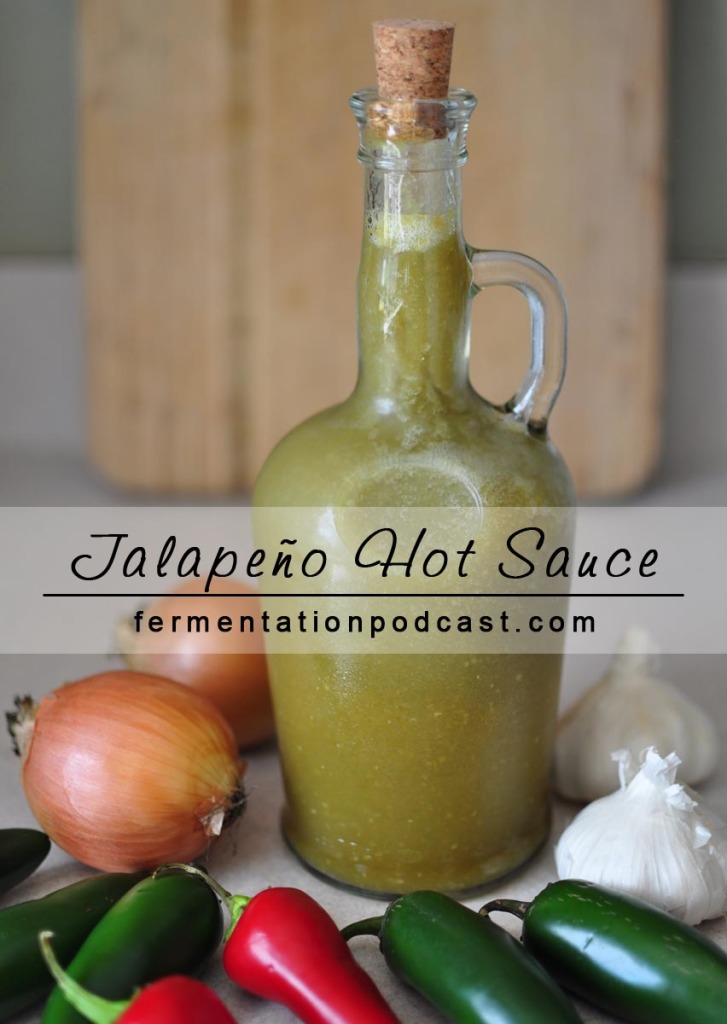
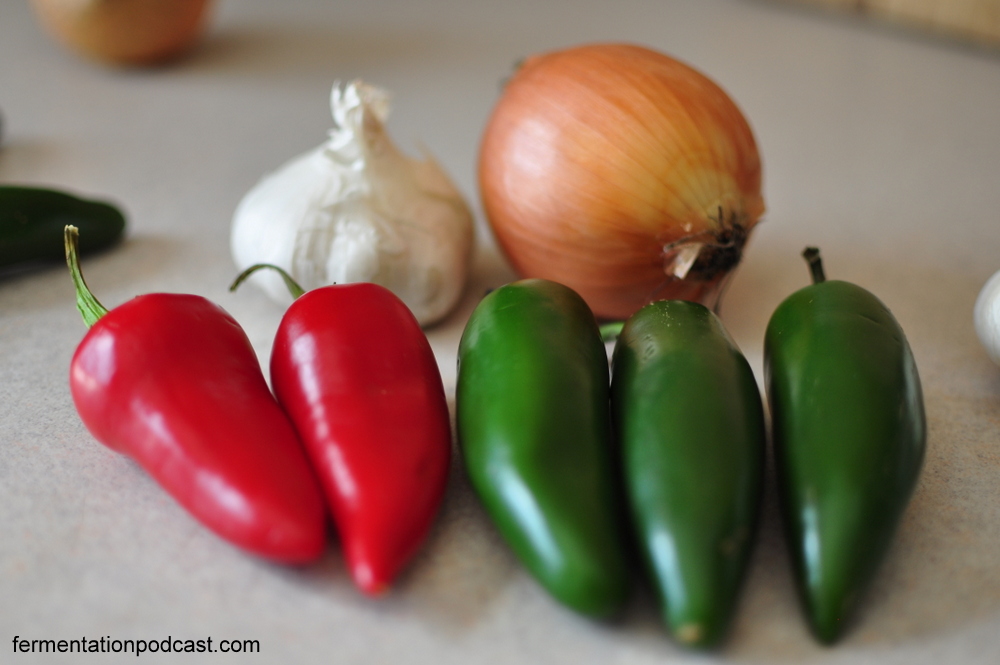
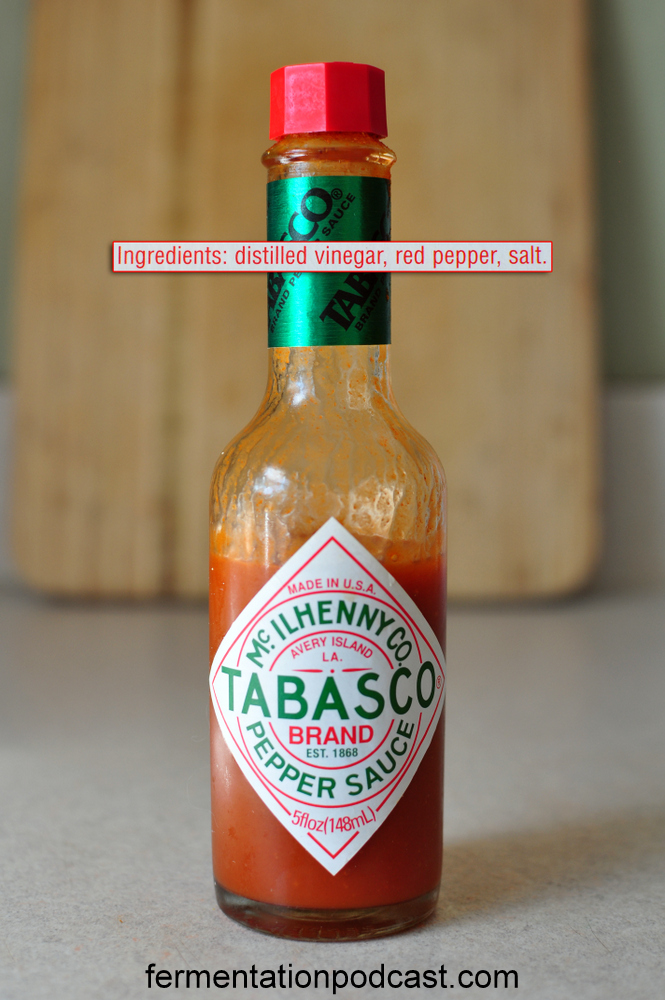

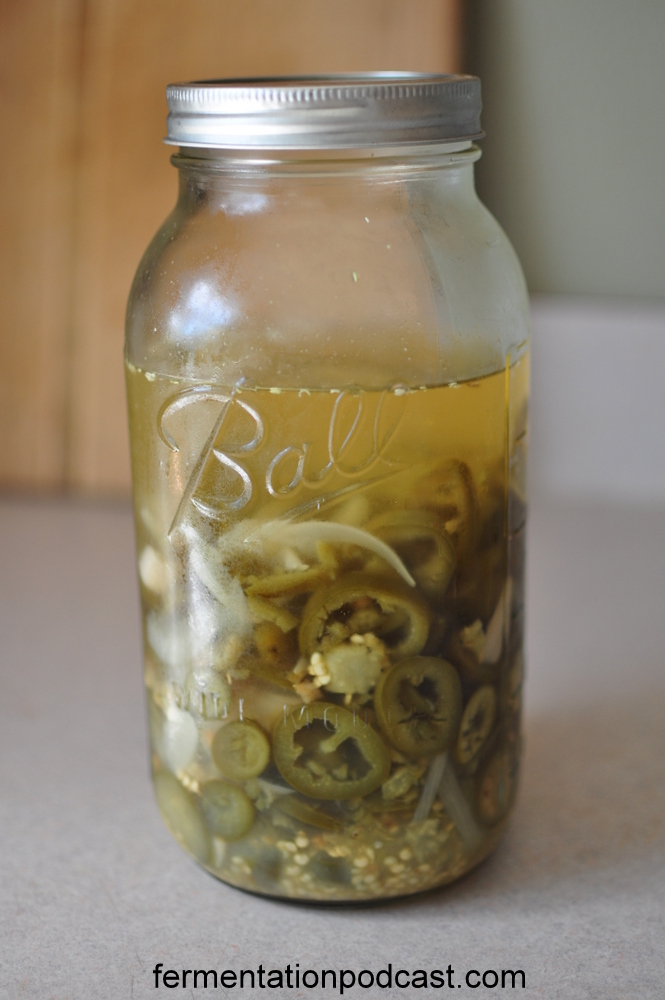


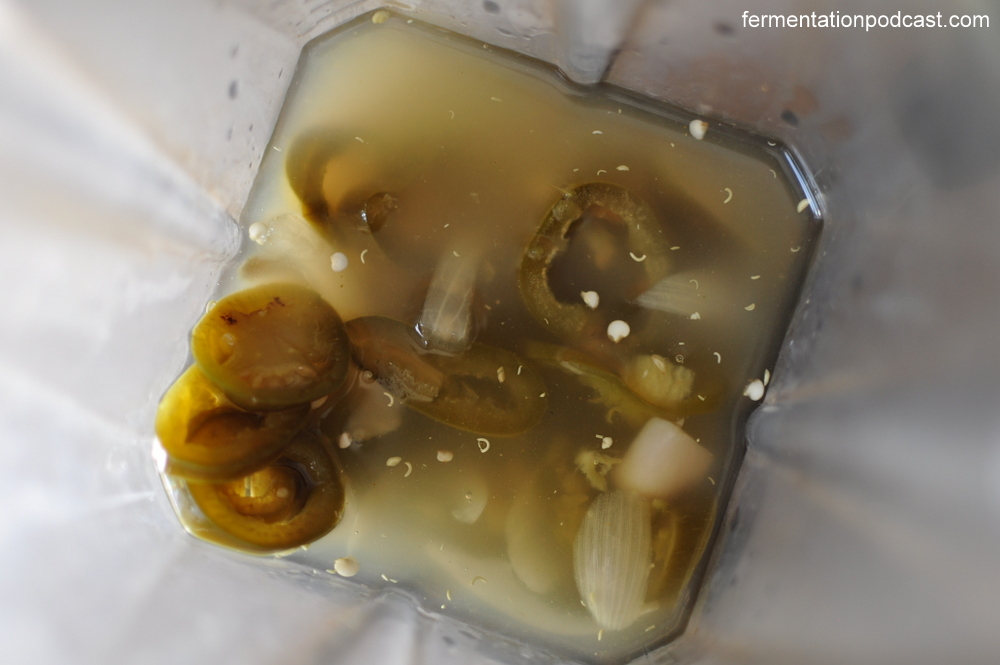
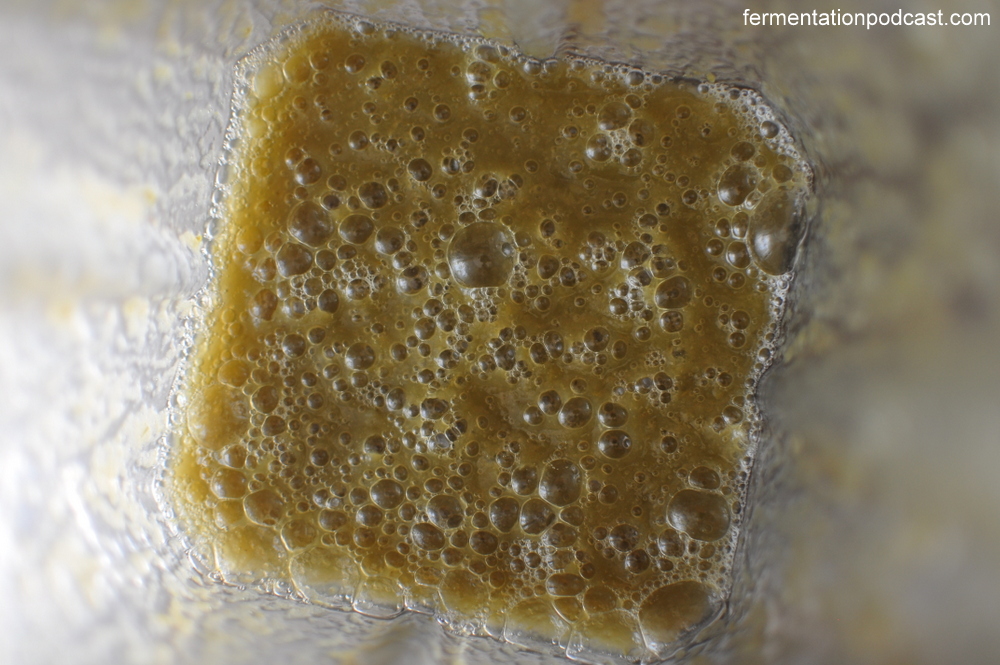
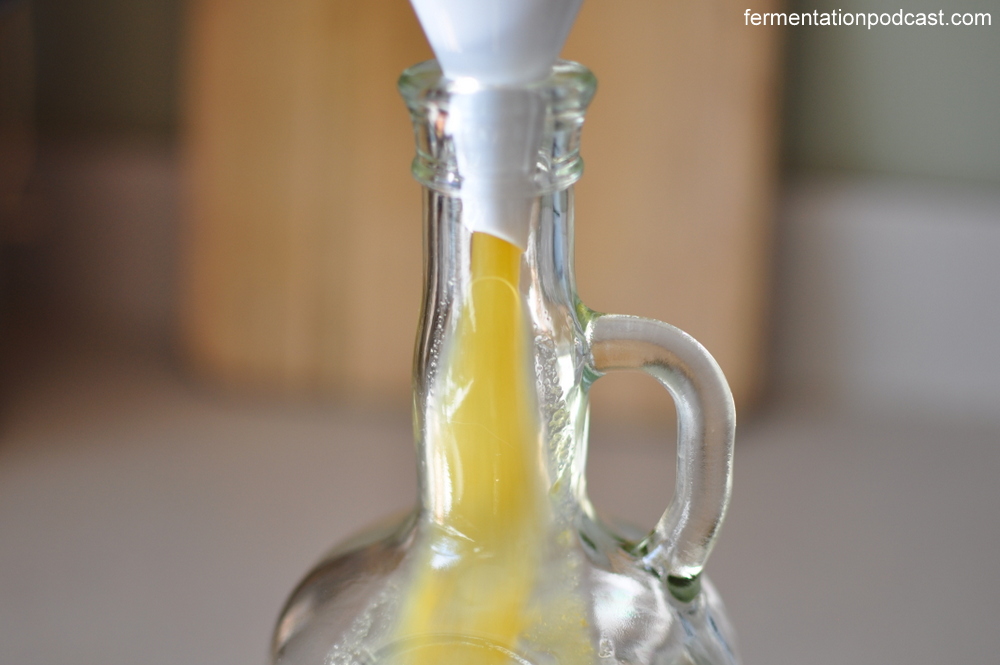
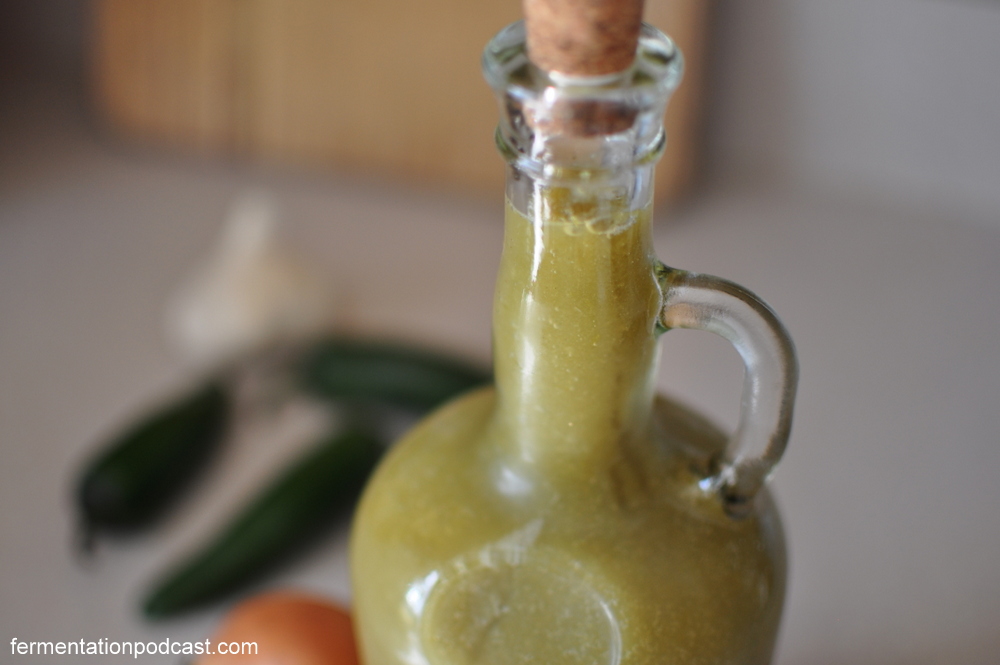


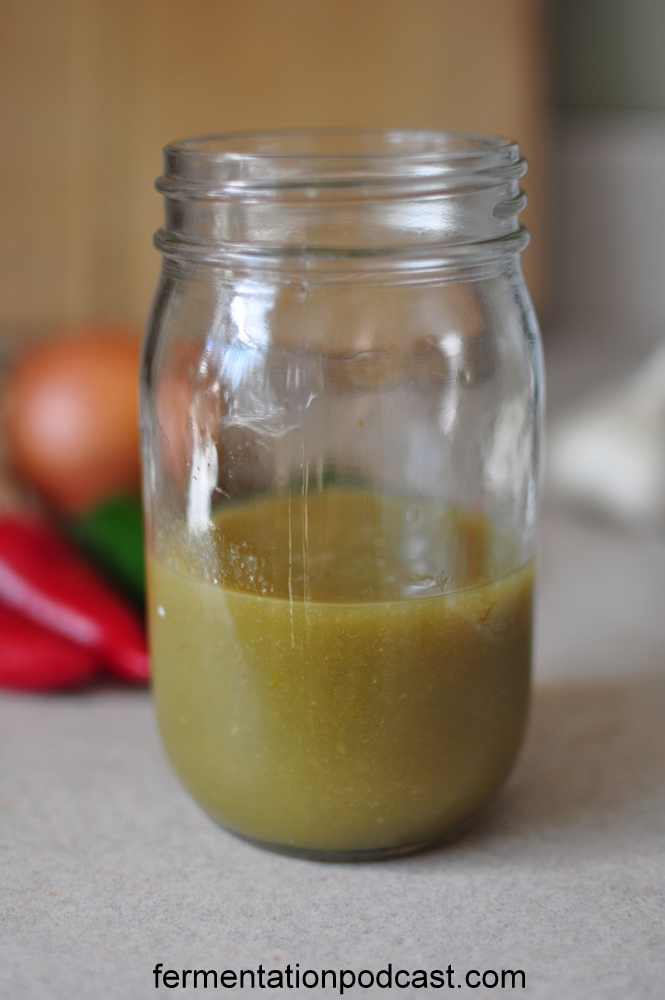
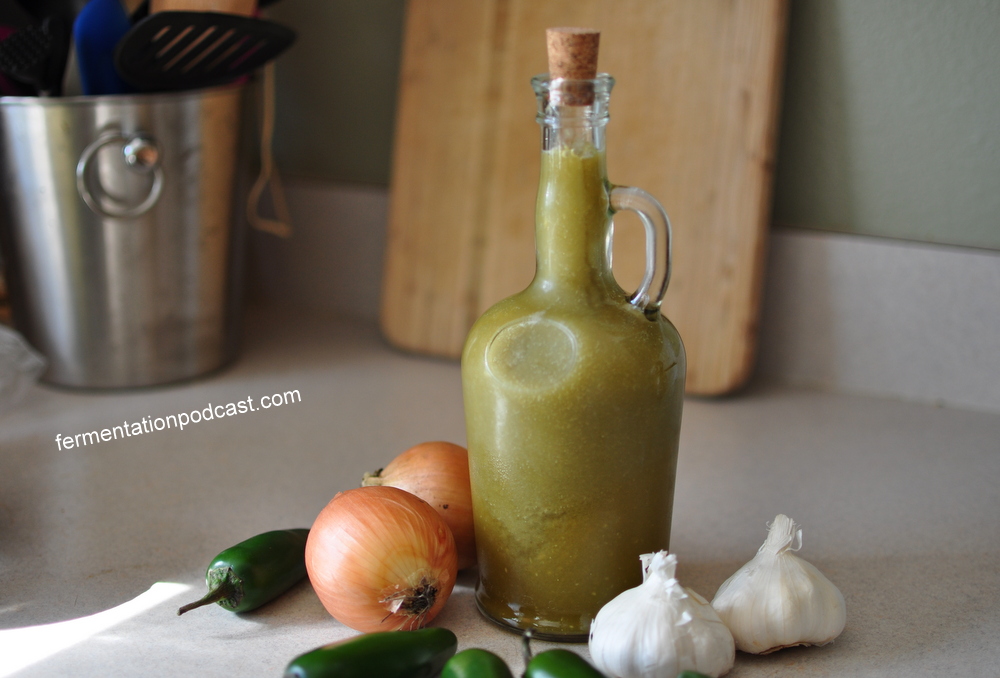
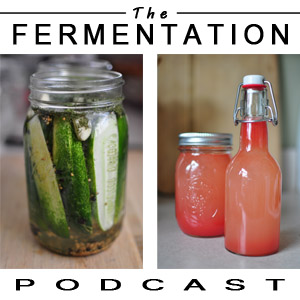

10 comments
3 pings
Skip to comment form
How could I add blueberries to this and achieve a shelf life?
HI,
I am trying your recipe for Jalapeño hot sauce. I started 12/14/18 but have seen no fermentation ( no bubbling ).We are using pickle pipes tops on the jars. Our kitchen temp is normally 68deg or so can this be the problem? Or should we let it go longer, today being January 13, 2019 or start over?. Or can I cook it from this point? I made some at the same time cooking Jalapeños and Fresnos with vinegar and it is very tasty ( my wife words ).
Any help is greatly appreciated.
Thanks, Scott & Peggy Davis
If you haven’t seen any bubbles in a month, start over. Make sure you are *not* using iodized salt or tap water if you’re having fermentation issues. The iodide in the iodized salt and the chlorinated tap water can potentially inhibit the bacteria carrying out the fermentation. Use spring water/distilled water and non-iodized salt, and see if that makes a difference.
Hi there i did this recipe and i really want to make sure it is safe for consumption.
I followed all of the directions listed. There was not much listed by way of making sure it was covered so i placed a paper towel over it with a rubber band to keep it from any contaminants. I let it ferment for just over a week until it stopped bubbling. It smells like hot sauce and i blended it but now i have reservations of whether leaving it open and not sealing or “burping’ it was a wrong decision. I would really like to try this and am excited about fermentation, i just want to do it right.
All the best
Michael
I have the same question regarding whether or not the jar should be covered (and with what) and whether it needs to be burped. with what I was able to put in to weigh down the peppers, I can’t fit the lid on, but I’m not sure that I need to. If I do put the lid on, should I burp? and how often?
Author
Hey Michael and Alison, thanks for the questions! When making hot sauce, I normally use the jelly jar method so the edges aren’t covered but I can see why you would want to cover it. One of the newer methods is to use glass fermentation weights to weigh down the contents and then put a fermentation lid on that lets the ferment off-gas while keeping it sealed from the air. This makes it to where nothing gets in and the gas gets out. You don’t have to burp the gases if it’s uncovered since they will naturally but be careful if you’re putting a tight cap on as the pressure will build up! If I’m covering due to bugs etc. I might only use a paper or cotton towel and rubber band. Hope that helps!
I make my own hard cider and have 10-20 gallons on hand at most times of the year. Other than having a glass or two I also use it to ferment my own hot sauce. Keep in mind that the cider has slowed from lack of sugar and is usually 1 year old or more. I pack 1 gallon jars with all assortments of hot peppers and add the hard cider and the yeast takes off again bubbling away. After 30 or more days the peppers are eaten up and the mixture is put through a food mill, not a blender or processor. The alcohol content of the sauce keeps it preserved and makes great sauce. Kind of like hot sauce wine.
How long does this jalapeno hot sauce store before going bad? Do I need to store it in the refrigerator, or just in the cabinet?
Hi there,
I’ve had peppers fermenting for several months. Basically I forgot about them. Is there a point of no return, meaning is there a point at how long fermentation is too long?
Greg
Hey Greg, if it’s short time maybe in the time frame of months, it should be just fine. Technically, Tobasco Sauce ferments their hot sauce in oak barrels for about 3 years! After a while though, it might to start tasting stale (like canned food) so I wouldn’t leave it too long. I’ve fermented hot peppers for about 2 months and they still tasted great. Hope that helps!
[…] Homemade Fermented Jalapeno Hot Sauce Recipe […]
[…] recently published my Fermented Jalapeno Hot Sauce Recipe and explained how to do it in Episode 12 – How to Make Homemade Fermented Hot Sauce, but with […]
[…] via Fermentation Podcast […]